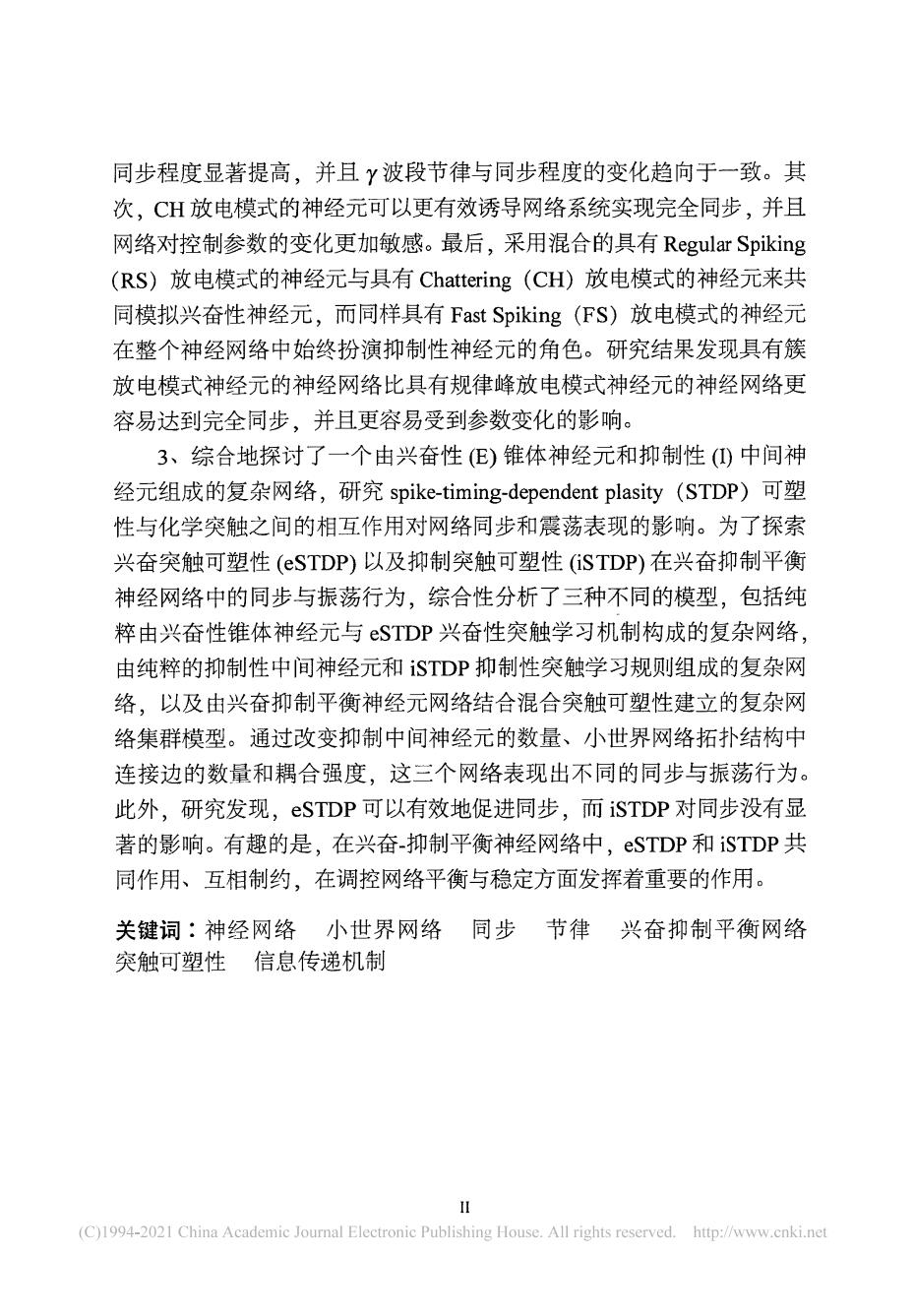
同步程度显著提高,并且γ波段节律与同步程度的变化趋向于一致。其 次,CH放电模式的神经元可以更有效诱导网络系统实现完全同步,并且 网络对控制参数的变化更加敏感。最后,采用混合的具有Regular Spiking (RS)放电模式的神经元与具有Chattering(CH)放电模式的神经元来共 同模拟兴奋性神经元,而同样具有Fast Spiking(FS)放电模式的神经元 在整个神经网络中始终扮演抑制性神经元的角色。研究结果发现具有簇 放电模式神经元的神经网络比具有规律峰放电模式神经元的神经网络更 容易达到完全同步,并且更容易受到参数变化的影响。 3、综合地探讨了一个由兴奋性(E)锥体神经元和抑制性()中间神 经元组成的复杂网络,研究spike-timing-dependent plasity(STDP)可塑 性与化学突触之间的相互作用对网络同步和震荡表现的影响。为了探索 兴奋突触可塑性(eSTDP)以及抑制突触可塑性(STDP)在兴奋抑制平衡 神经网络中的同步与振荡行为,综合性分析了三种不同的模型,包括纯 粹由兴奋性锥体神经元与STDP兴奋性突触学习机制构成的复杂网络, 由纯粹的抑制性中间神经元和STDP抑制性突触学习规则组成的复杂网 络,以及由兴奋抑制平衡神经元网络结合混合突触可塑性建立的复杂网 络集群模型。通过改变抑制中间神经元的数量、小世界网络拓扑结构中 连接边的数量和耦合强度,这三个网络表现出不同的同步与振荡行为。 此外,研究发现,eSTDP可以有效地促进同步,而iSTDP对同步没有显 著的影响。有趣的是,在兴奋-抑制平衡神经网络中,eSTDP和iSTDP共 同作用、互相制约,在调控网络平衡与稳定方面发挥着重要的作用 关键词:神经网络小世界网络同步节律兴奋抑制平衡网络 突触可塑性信息传递机制 (C)1994-2021 China Academic Joumal Electronic Publishing House.All rights reserved.http:/www.cnki.net
同 步程度显著提高 , 并且 y 波段节律与 同 步程度 的 变化趋 向 于一 致 。 其 次 , CH 放 电模式 的 神经元可 以更有效诱导 网 络系统实现完全 同 步 , 并且 网 络对控 制参数 的 变化更加敏感 。 最 后 , 采用 混合 的 具有 Regul ar S p iki ng ( RS ) 放 电模式 的 神 经元与具有 Ch at t er i ng ( CH ) 放 电模式 的 神经兀来共 同 模拟兴奋性神经元 , 而 同 样具有 F ast Sp i ki ng ( F S ) 放 电模式 的 神经元 在整个 神 经 网 络 中 始终扮演 抑制性 神经 元 的 角 色 。 研究结果 发现具有簇 放 电模式 神经元 的 神 经 网 络 比具有规律峰放 电模式神经元 的 神 经 网 络更 容易达到 完全 同 步 , 并且更容 易 受到参数变化 的 影 响 。 3 、 综 合地探讨 了 一 个 由 兴奋性 ( E ) 锥体 神 经 元 和 抑 制性 ( I ) 中 间 神 经元组成 的 复杂 网 络 , 研究 s p i ke - t i m i ng - dep end e nt p l a s i ty ( S TDP ) 可塑 性与化学 突触之 间 的 相 互 作用 对 网 络 同 步和 震荡表 现 的 影 响 。 为 了 探索 兴奋 突触可塑性 ( e S TDP ) 以 及抑制 突触可塑性 ( i S TDP ) 在兴奋抑 制 平衡 神经 网 络 中 的 同 步与 振荡行为 , 综合性分析 了 三种不 同 的模型 , 包括纯 粹 由 兴奋 性锥体 神 经 元 与 e S TDP 兴 奋性 突触学 习 机制 构成 的 复杂 网 络 , 由 纯粹 的 抑制性 中 间 神经元和 i S TDP 抑 制性突触学 习 规则组成 的 复 杂 网 络 , 以 及 由 兴奋抑 制 平衡神经元 网 络结合混合 突触可塑性建立 的 复杂 网 络集群模型 。 通过 改 变抑 制 中 间 神经元 的 数量 、 小 世界 网 络拓扑结构 中 连 接 边 的 数量 和 耦 合 强度 , 这 三 个 网 络表现 出 不 同 的 同 步与 振荡 行为 。 此 外 , 研究发现 , e S TDP 可 以有效地促进 同 步 , 而 i S TDP 对 同 步没有显 著 的 影 响 。 有趣 的 是 , 在兴奋- 抑制平衡神经 网 络 中 , e S TDP 和 i S TDP 共 同 作用 、 互相制 约 , 在调 控 网 络平衡与稳定方面发挥着重要 的作用 。 关键词 : 神 经 网 络 小 世 界 网 络 同 步 节 律 兴 奋 抑 制 平 衡 网 络 突触可塑性 信息传递机制 I I
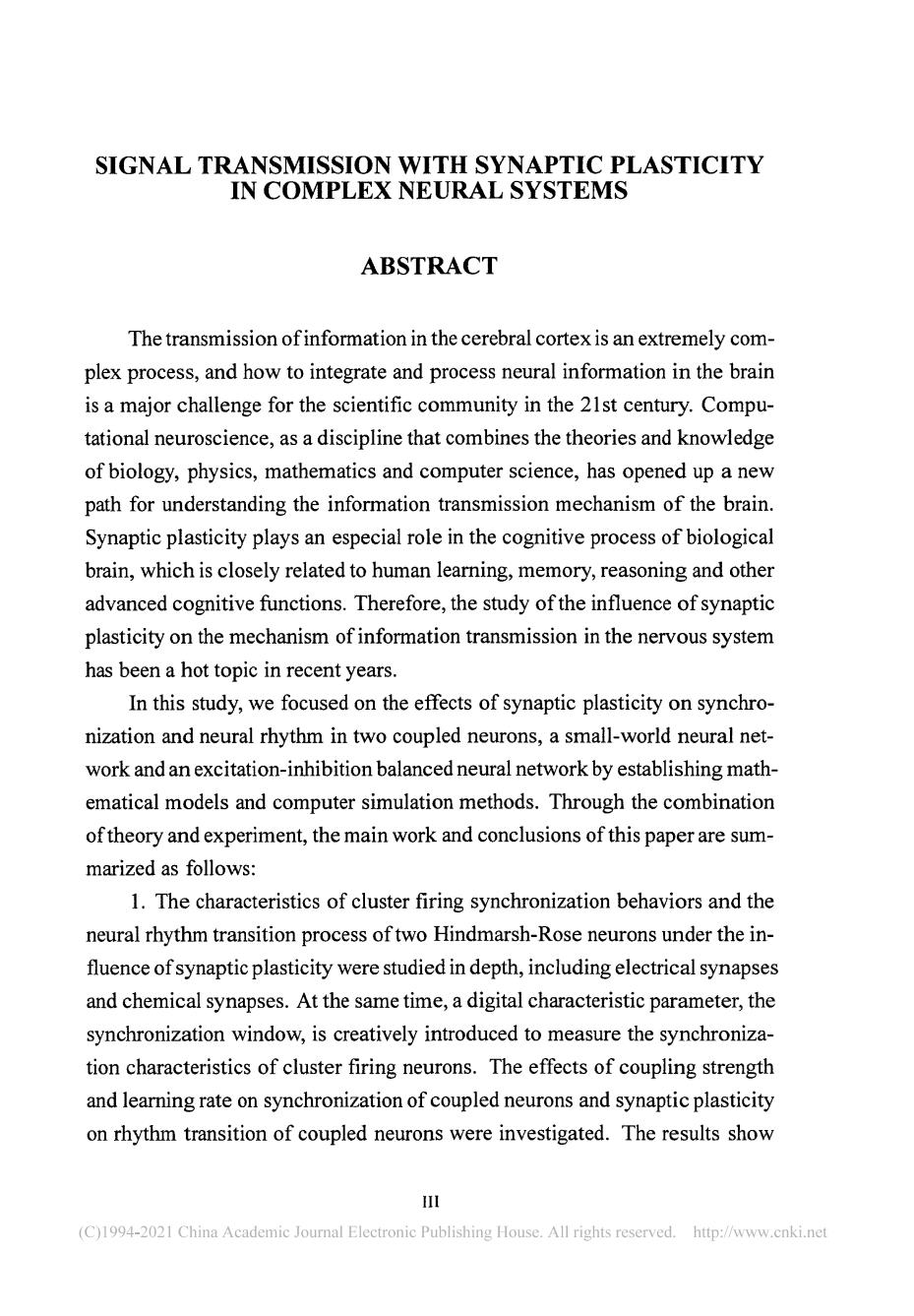
SIGNAL TRANSMISSION WITH SYNAPTIC PLASTICITY IN COMPLEX NEURAL SYSTEMS ABSTRACT The transmission ofinformation in the cerebral cortex is an extremely com- plex process,and how to integrate and process neural information in the brain is a major challenge for the scientific community in the 21st century.Compu tational neuroscience,as a discipline that combines the theories and knowledge of biology,physics,mathematics and computer science,has opened up a new path for understanding the information transmission mechanism of the brain. Synaptic plasticity plays an especial role in the cognitive process of biological brain,which is closely related to human learning,memory,reasoning and other advanced cognitive functions.Therefore,the study of the influence of synaptic plasticity on the mechanism of information transmission in the nervous system has been a hot topic in recent years. In this study,we focused on the effects of synaptic plasticity on synchro- nization and neural rhythm in two coupled neurons,a small-world neural net- work and an excitation-inhibition balanced neural network by establishing math- ematical models and computer simulation methods.Through the combination of theory and experiment,the main work and conclusions of this paper are sum- marized as follows: 1.The characteristics of cluster firing synchronization behaviors and the neural rhythm transition process of two Hindmarsh-Rose neurons under the in- fluence of synaptic plasticity were studied in depth,including electrical synapses and chemical synapses.At the same time,a digital characteristic parameter,the synchronization window,is creatively introduced to measure the synchroniza- tion characteristics of cluster firing neurons.The effects of coupling strength and learning rate on synchronization of coupled neurons and synaptic plasticity on rhythm transition of coupled neurons were investigated.The results show C)1994-2021 China Academic Joumal Electronic Publishing House.All rights reserved. /www.cnki.net
S I GNAL TRANSMI S S I ON WI TH SYNAPTI C PLAS TI CI TY I N C OMPLEX NEURAL SYS TEMS AB S TRAC T The t rans mi s s i on o f i nfo rmat i on i n the c e rebral c ort e x i s an ext reme l y c om? p l ex pro c e s s , and how t o i nteg rat e and p r o c e s s neur al i n format i o n i n t h e brai n i s a maj or c hal l e ng e for t he s c i ent i fi c c ommuni ty i n t he 2 1 s t c e ntury. C o mp u? tat i onal ne uro s c i enc e , as a d i s c i p l i ne that c omb i ne s the t he or i e s and knowl edge o f bi o l o gy, phy s i c s , mathe mat i c s and c omput er s c i enc e , has op ene d up a n ew pat h for un der s t and i ng th e i nformat i o n t ran s mi s s i on me chani s m o f the bra i n . Syn ap t i c p l as t i c i ty p l ay s an e s p e c i a l r o l e i n t he c o gni t i v e p ro c e s s o f b i o l o gi c al brai n , whi c h i s c l o s e l y re l at e d t o human l e arni ng , me mo ry, re as oni ng and other advanc e d c o gni ti v e fun ct i on s . The r e fore , th e s tudy o f t he i n fl u e nc e o f s yn apt i c p l as t i ci ty on the me c hani s m o f i nformat i on t ran smi s s i on i n t h e nerv o u s s y s t em h as be en a h ot t op i c i n re c ent y e ar s . In t hi s s tudy, we fo c us e d on t he e ffe c t s o f synap t i c p l as t i c i ty on synchro? ni zati on and neural rhythm i n t wo c o up l e d ne uron s , a s mal l - wor l d ne ural net ? work and an e xc i t at i on- i nhi b i t i o n b al anc e d neural ne t wor k by e s t ab l i s hi ng math- emat i c al mod e l s and c omputer s i mul at i on met h o ds . Through the c omb i nat i o n o f the ory and exp er i ment , the mai n work and c onc l u s i ons o f thi s p ap er ar e s um? mari ze d a s fo l l ows : 1 . Th e char act eri st i c s o f c l u st e r fi r i ng s yn chroni zat i on b ehavi ors and t he n eural rhyt hm trans i t i on p ro c e s s o f t wo Hi ndmar s h - Ro s e ne ur on s unde r th e i n? fl uenc e o f s ynapt i c p l as t i c i ty were st ud i e d i n d ep th, i nc l ud i ng el e c tr i c al s ynap s e s and chemi c al sy nap s e s . At the s ame t i me , a d i gi t al ch aract e r i s t i c p ar amet er, t he s y nchro ni zat i on wi ndow, i s cre at i vel y i ntro duc e d t o me a s ur e the s ynchro ni za ? t i on c hara ct eri s ti c s o f c l us t er fi ri ng ne urons . The e ffe ct s o f c oupl i n g s trength and l e arni ng rat e on s ynchroni zat i o n o f c oup l e d ne uro ns an d synap t i c p l as t i c i t y on rhy thm t ran s i t i o n o f c oupl e d ne ur on s we re i nve st i gat ed . The r e s ul t s s ho w h i
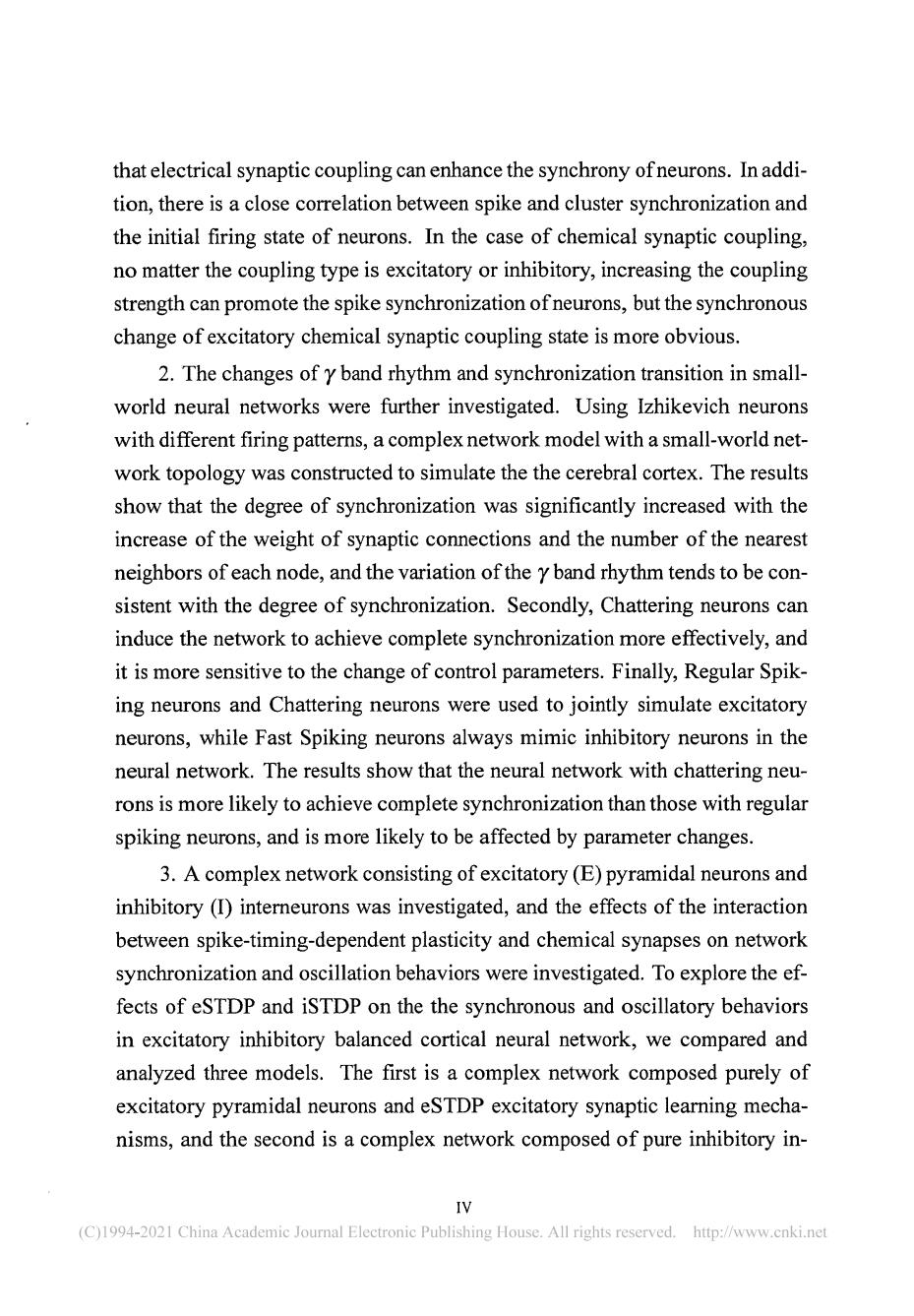
that electrical synaptic coupling can enhance the synchrony ofneurons.In addi- tion,there is a close correlation between spike and cluster synchronization and the initial firing state of neurons.In the case of chemical synaptic coupling, no matter the coupling type is excitatory or inhibitory,increasing the coupling strength can promote the spike synchronization of neurons,but the synchronous change of excitatory chemical synaptic coupling state is more obvious. 2.The changes of y band rhythm and synchronization transition in small- world neural networks were further investigated.Using Izhikevich neurons withdere firing patters,acomplex network model withasmall-worldnet- work topology was constructed to simulate thethe cerebral cortex.The results show that the degree of synchronization was significantly increased with the increase of the weight of synaptic connections and the number of the nearest neighbors of each node,and the variation of the y band rhythm tends to be con- sistent with the degree of synchronization.Secondly,Chattering neurons can induce the network to achieve complete synchronization more effectively,and it is more sensitive to the change of control parameters.Finally,Regular Spik- ing neurons and Chattering neurons were used to jointly simulate excitatory neurons,while Fast Spiking neurons always mimic inhibitory neurons in the neural network.The results show that the neural network with chattering neu- rons is more likely to achieve complete synchronization than those with regular spiking neurons,and is more likely to be affected by parameter changes. 3.A complex network consisting of excitatory(E)pyramidal neurons and inhibitory (I)interneurons was investigated,and the effects of the interaction between spike-timing-dependent plasticity and chemical synapses on network synchronization and oscillation behaviors were investigated.To explore the ef fects of eSTDP and iSTDP on thethe synchronous and oscillatory behaviors in excitatory inhibitory balanced cortical neural network,we compared and analyzed three models.The first is a complex network composed purely of excitatory pyramidal neurons and eSTDP excitatory synaptic learning mecha- nisms,and the second is a complex network composed of pure inhibitory in- IV (C)1994-2021 China Academie Joumal Electronic Publishing House.All rights reserved.http:/www.cnki.net
that e l e ctri c al s yn ap t i c c oup l i ng c an enhanc e t he synchr ony o f neur ons . In addi ? t i o n, t here i s a c l o s e c o rrel at i o n betwe en s p i ke and cl us t e r s y nchro ni z at i on and the i ni t i al fi r i ng s t at e o f neurons . In t he c as e o f c hemi c al synapt i c c o up l i ng , no mater th e c o up l i n g typ e i s exc i t at ory or i nhi b i t ory, i ncre as i ng the c o upl i n g s tr ength c an pr o mot e the s p i ke s ync hr o ni z at i on o f ne urons , b ut th e sync hr onous change o f e xc it at ory chemi c al s ynapti c c oup l i ng s t ate i s mor e o b vi o u s . 2 . Th e c hange s o f 7 b and rhythm and s ync hroni z at i o n t rans i t i on i n s mal l - worl d neural n et works wer e furt h er i nve s t i gat e d . Us i ng I zhi kevi ch neur on s wi t h di ffere nt fi ri ng p at t erns , a c omp l ex ne t wo rk mo de l wi t h a s mal l - wor l d net ? work t op ol o gy was c on s truct e d t o s i mul at e t he the c erebr al c ort e x . The r e s ul t s s ho w t hat t he de gre e o f s ync hr o ni z at i o n was s i gni fi c ant l y i ncre as e d wi th t h e i n cr e as e o f the we i ght o f s ynap t i c c onne ct i on s and the numb er o f t he n e are st n ei gh b or s o f e ac h node , and the v ari at i o n o f the 7 b an d rhythm t ends t o b e c on- s i s t ent wi th the d e gre e o f s ynchron i z at i o n . S ec ondly, Chater i ng ne ur on s c an i nduce th e netwo rk t o achi e ve comp l et e sy nc hr o ni zat i on more e ffe ct i ve l y, an d i t i s more s e n s i t i v e t o the change o f c o ntro l p arame t e r s . F i nal l y, Re gu l ar S p i k? i ng n eur o ns and Ch att eri ng neur on s we r e us e d t o j o i nt l y s i mu l at e exc i t at ory neur ons , whi l e F a s t S p i ki ng neuron s al ways mi mi c i nhi b i t ory neurons i n t he n eural n et work . Th e re s ul t s s how t hat th e neural network wi t h c hatt er i n g neu? ro n s i s more l i k e l y t o ac h i eve c omp l et e s yn chroni zat i on than t ho s e wi t h regul ar s p i ki n g neurons , an d i s more l i ke l y t o b e affe ct e d by p ar amet er change s . 3 . A c omp l ex net work c ons i s t i ng o f exc i tat ory ( E) pyrami d al ne uron s and i nhi bi t ory ( I ) i nt emeur on s was i nve s t i gat e d , and the e ffe ct s o f the i nt er act i o n b et we en s pi ke- t i mi n g - d ep endent p l a s t i c i t y an d che mi c al syn ap s e s on network s y nchroni z at i on and o s c i l l at i on b e hav i or s wer e i nv e s t i g at e d . To exp l ore the ef? fe c t s o f e S TDP and i S TDP on the the s y n c hro no us and o s c i l l at ory b ehav i or s i n e xc i tato ry i nhi b i t ory b al anc e d c ort i c al neural network , we c omp are d an d an al yze d t hr e e mod e l s . The fi r s t i s a c omp l ex net work c omp o s ed pure l y o f exc i t at ory pyram i d al neurons and e S TDP exc i t at ory s ynap t i c l e arni ng mecha ? ni s ms , and the s e c ond i s a c omp l ex net work c ompo s e d o f p ur e i nhi b i t ory i n- I V
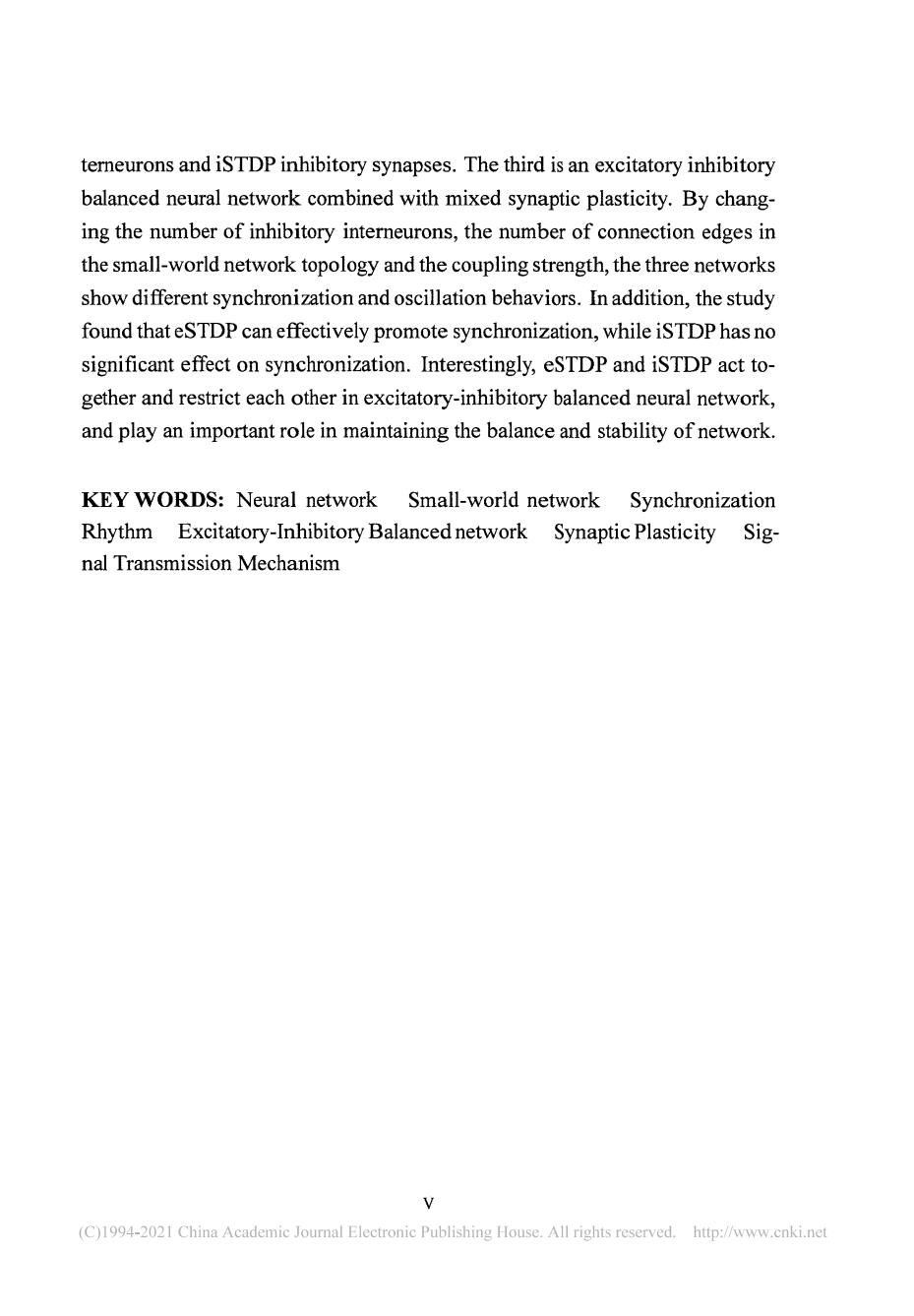
terneurons and iSTDP inhibitory synapses.The third is an excitatory inhibitory balanced neural network combined with mixed synaptic plasticity.By chang- ing the number of inhibitory interneurons,the number of connection edges in the small-world network topology and the coupling strength,the three networks show different synchronization and oscillation behaviors.In addition,the study found that eSTDP can effectively promote synchronization,while iSTDP has no significant effect on synchronization.Interestingly,eSTDP and iSTDP act to- gether and restrict each other in excitatory-inhibitory balanced neural network, and play an important role in maintaining the balance and stability of network. KEY WORDS:Neural network Small-world network Synchronization Rhythm Excitatory-Inhibitory Balanced network Synaptic Plasticity Sig- nal Transmission Mechanism (C)1994-2021 China Academie Joumal Electronic Publishing House.All rights reserved.http://www.cnki.net
t emeurons and i S TDP inhi b i t ory s ynap s e s . The thi rd i s an exc i t at o ry i nh i bi tory b al anced neural network c ombine d with mi xe d synapt i c p l ast i c i ty. By chang ? i ng t he numb er o f i nhi b i t ory i nt emeurons , t he numb er of c o nne ct i on e d ge s i n the s mal l - worl d net work t op o l ogy and t h e c oup l i ng s trength , t he t hre e net wo rks s how di ferent s y nchroni zat i on and o s c i l l at i o n b ehav i or s . In ad di t i on, the s tudy found t hat e S TDP c an e ffe ct i ve l y pro mot e s ynchroni z at i o n, whi l e i STDP has no s i gni fi c ant e ffe ct on s yn c hroni zat i on . I ntere st i ng l y, e S TDP and i S TDP act t o? get her an d re s t r i ct e ach ot h e r i n e xc i t at o ry - i nhi b i t o ry b al an c e d n e ur al net work , and p l ay an i mp ortant r o l e i n mai nt ai ni ng the b al anc e and s tab i l i ty o f ne two rk . KE Y WORDS : Neura l net work S ma l l - wor l d n et work S ync hron i z at i on Rhyt hm Exc i t at ory - I nh i b i t ory B al anc e d network Syn apt i c P l a s t i c i t y S i g ? n al Tr an s mi s s i on Me ch an i s m v
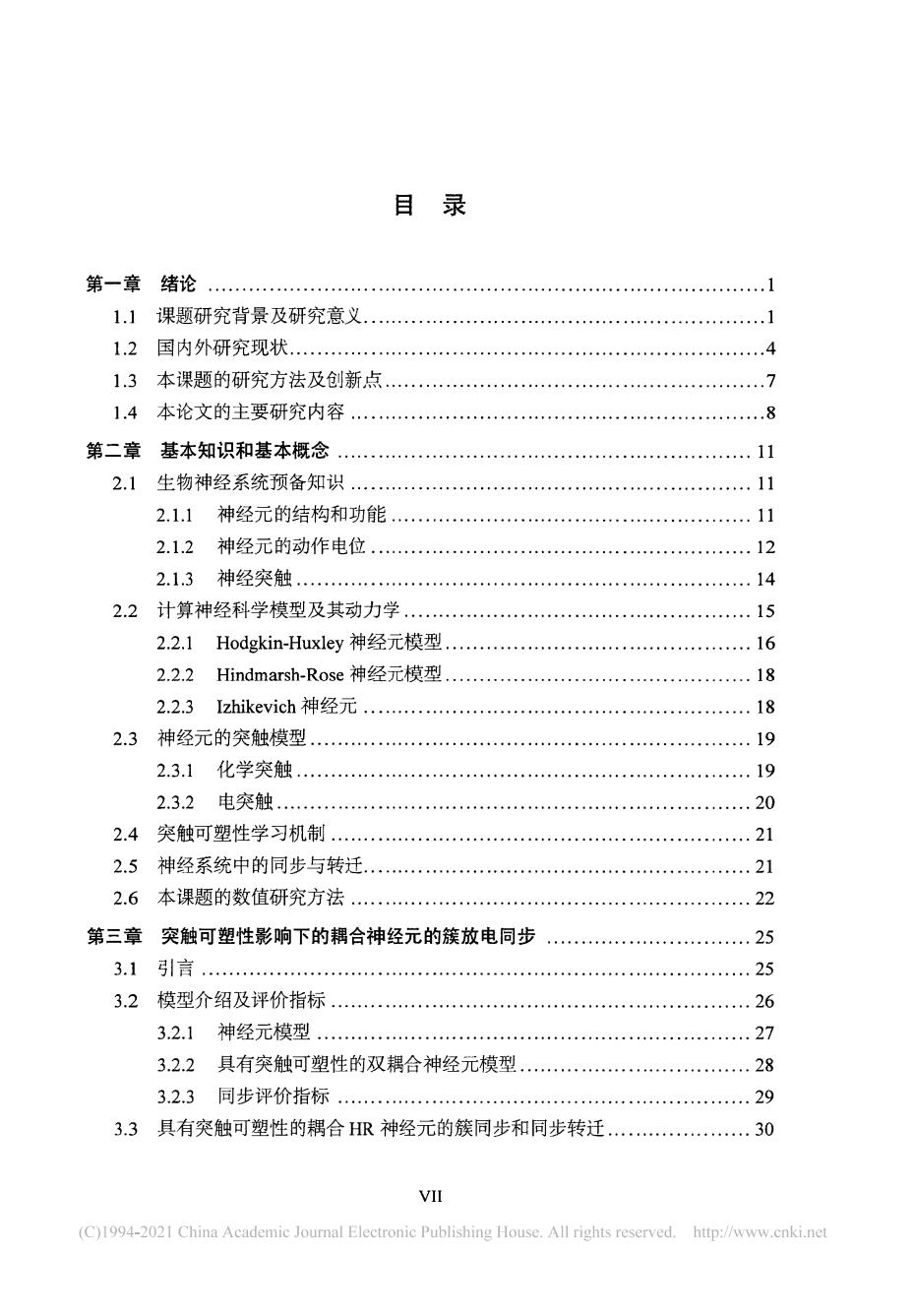
目录 第-章绪论1 1.】课题研究背景及研究意义. 1.2国内外研究现状. 4 1.3本课题的研究方法及创新点.7 1.4本论文的主要研究内容8 第二章基本知识和基本概念.1】 2.1生物神经系统预备知识.11 2.11神经元的结构和功能.11 2.1.2神经元的动作电位.12 2.1.3神经突触.14 22计算神经科学模型及其动力学.15 22.1 Hodgkin-Huxley神经元模型.16 2.2.2 Hindmarsh-Rose神经元模型.18 22.32 zhikevich神经元.18 23神经元的突触模型.19 2.3.1化学突触.19 2.3.2电突触.20 2.4突触可塑性学习机制.21 2.5神经系统中的同步与转迁.21 2.6本课题的数值研究方法.22 第三章突触可塑性影响下的耦合神经元的簇放电同步.25 3.1引言.25 3.2模型介绍及评价指标.26 3.2.1神经元模型.27 3.2.2具有突触可塑性的双耦合神经元模型.28 3.2.3同步评价指标 .29 3.3具有突触可塑性的耦合HR神经元的族同步和同步转迁.30 VII (C)1994-2021 China Academic Joumal Electronic Publishing House.All rights reserved.http://www.cnki.net
目 录 第 一 章 绪论 1 1 」 课题研究背景及研 究意义 1 1 . 2 国 内 外研究现状 4 1 . 3 本课题 的 研究方法及创 新点 7 1 . 4 本论文 的 主要研究 内 容 8 第 二 章 基本 知 识和 基 本概念 1 1 2 . 1 生物 神经 系 统预备知 识 1 1 2 . 1 . 1 神经元 的 结构和 功 能 1 1 2 . 1 . 2 神经元 的 动作 电 位 1 2 2 . 1 . 3 神经突触 1 4 2 . 2 计算神经科学模型及其动 力 学 1 5 2 . 2 . 1 Ho dgki n- Huxl e y 神 经元模型 1 6 2 . 2 . 2 Hi ndm ar s h - Ro s e 神经元模型 1 8 2 . 2 . 3 I zhike vi c h 神经元 1 8 2 . 3 神经元 的 突触模型 1 9 2 . 3 . 1 化 学突触 1 9 2 . 3 . 2 电 突触 2 0 2 . 4 突触可塑性学 习 机制 2 1 2 . 5 神 经 系统 中 的 同 步与转迁 2 1 2 . 6 本课题 的 数值研究方法 2 2 第 三 章 突触 可 塑性影 响 下 的 耦 合 神经元 的簇 放 电 同 步 2 5 3 . 1 引 言 2 5 3 . 2 模型介绍 及评价指标 2 6 3 . 2 . 1 神经元模型 2 7 3 . 2 . 2 具有突触可塑性 的 双耦合神经 元模型 2 8 3 . 2 . 3 同 步评价指标 2 9 3 . 3 具有突触可塑性 的 耦合 HR 神经元 的 簇 同 步和 同 步转迁 3 0 VI I